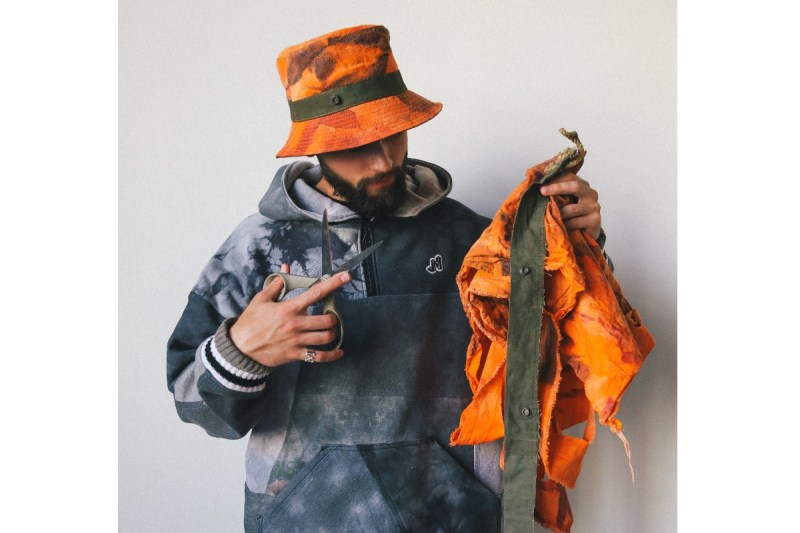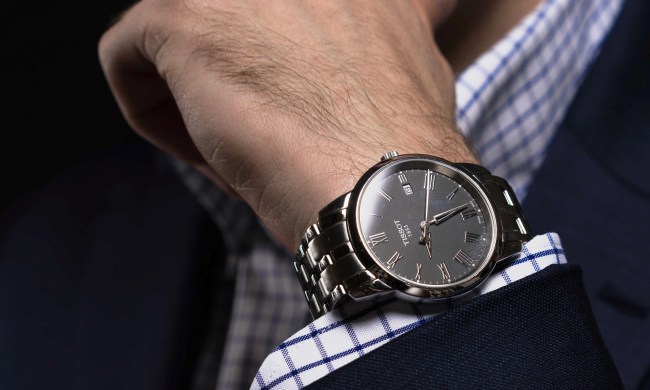The first season of HBO Max’s The Hype, a competition for designing the best street-worthy clothing, ended August 2021 with Justin Mensinger’s upcycled, sustainable fashion and cutting-edge designs taking home the gold chain.
A year later, Mensinger has moved across the country to be closer to resources and to film season 2. As the fall fashion season approaches, Mensinger raps with The Manual about his latest creations, a new collab with Fiskars sewing tools, and how the hot textile stylist is continuing to work to promote sustainable design.

(The following conversation has been edited for clarity.)
TM: So, are you in Chicago right now, Justin?
Justin Mensinger: I’m actually in L.A. I’ve lived in L.A. for about a year and a half now.
TM: Did you move there, because it’s more of a fashion-forward place?
Justin Mensinger: One hundred percent. I was trying to manifest moving here for a few years, so I put the intention out there to have more resources to be able to create more and be closer to a lot of the things I needed to be able to get production done.
TM: It seems like L.A. is not only fashion forward, but there are actually resources there. There’s capital that you can get for your clothing and for your production.
Justin Mensinger: When I was in Chicago, I would have to order everything, whether it be a sewing machine or something as simple as needles or thread. I feel like everything came from L.A. and now that I’m here, I can drive five to 10 minutes east and find what I need.
TM: You’ve got a partnership with Fiskar coming up, and you also have an additional drop, is that correct?
Justin Mensinger: I’m also working on some of my own projects, as well. For the next month, I’m having my first pop up in L.A., and then I’m working on a sub-brand right now.
TM: Tell us about the pop-up.
Justin Mensinger: It will be on Melrose at this place called Reconstruct Studio. I actually know the owner of the store. I’ve worked with him before on other projects, and he does upcycling as well. It’s a similar style. I’ll have half of the floor, and we’ll have artwork, a dirt bike, and a whole patchwork wall.
TM: It seems like streetwear is very fashion-forward and has been for the last 10-20 years…
Justin Mensinger: One hundred percent. I think also upcycling is coming into that picture, as well. Reusing materials really ties in with streetwear because a lot of it is upcycling vintage, or things that are discarded.
That’s one reason I’m really excited to work with Fiskars on this project. I’m able to incorporate tools that are sustainable, recycled, renewable, and 85% reusable steel for the blades. I’m reusing things that have already stood the test of time.
TM: Do you feel like this was inspired by your generation?
Justin Mensinger: A lot of my inspiration started really young, but it was very subconscious.
When I was a kid, I would go with my grandmother to the fabric store, the craft store, and I would see her do a lot of quilts. I didn’t really realize she was upcycling at the time. My grandmother also used Fiskars scissors. Just being around her inspired me, and those things didn’t really come into play until I was much older.
I also worked at Goodwill in high school for about two years, and I saw how many things were donated and not resold. They were discarded and sent to another country. I used to take the clothes in donations, bail them up in the back with a forklift, and literally force semis full.
Then working at RSVP Gallery in Chicago, which is more of a boutique. Virgil Abloh started it with Don C, and this went on to have a lot of influence. Between those different experiences in my life, and the things I was interested in growing up like skateboarding, vintage clothes… they kind of all came together.
TM: It sounds like you’ve been interested in this your whole entire life — designing and making clothing. Who did you learn from?
Justin Mensinger: I feel like I had to teach myself everything. When I started, it was more so having the idea of having my own brand, but not knowing how to go about it. I started really small and simple. I would get blank t-shirts offline, and I would go to Hobby Lobby and get iron-on letters and a $20 iron and spend hours trying to get the letters perfectly aligned. I would hand bleach dye shirts… anything I could to make the vision in my head come to life.
When I was older, like 18-19, I was trying to work on making hats. I was doing everything myself by hand and learning as I went. I really wanted to expand and have something that I built from the ground up. When I started looking into cutting, production, and making clothes from scratch, there was really no fabric stores.
I started practicing sewing by taking (stained or ruined) garments and using them to make samples of sweat shorts or hoodies because I didn’t want to mess up the expensive fabric if I got some. I was falling in love with the process of actually reusing things and cutting things up.
I have an example of what I’m working with Fiskars. It’s a teaser for what I’m going to be doing, an accessory to complement that piece. It’s a bucket hat made from a scrap of canvas, painted and hand-dyed. There’s the edge of a vintage army tent.
TM: Why those colorways? To represent the season?
Justin Mensinger: I really wanted to tie in olive green colorways as that fall inspiration of altering seasons. Especially coming from Michigan and the Midwest, this really resonated with me — this time of year and the sustainability aspects. Orange really pops, but it’s also reminiscent of being in the woods or even of the scissors themselves. Orange has always been one of my favorite colors.
TM: What’s the difference then, between creating something functional and creating art?
Justin Mensinger: I think the difference between art and a commodity is really the soul put into it, the message behind it, and the thought behind it. Great art can be universally recognized, and a great product. A good piece of design is a piece of art. With upcycling things, there’s a certain soul behind it. The material’s already lived a life of its own.
That’s one thing I’m excited to be able to share. We’re (Fiskars and Mensinger) going to be giving away kits where people can actually upcycle pieces of their own. Maybe they have a piece that they’ve already had a lot of life experiences in, and then they’re able to recreate that into something that has a story and a message behind it. That’s where art lives: in how you reinterpret something, putting your own twist on it — that handmade element.
Watch for more details from Mensinger’s Instagram, @justinmensinger, for upcoming September events including his pop-up on Melrose, September 16-17, and his work with Fiskars coming Sept. 26.



